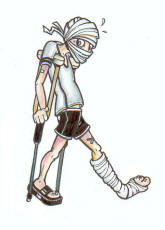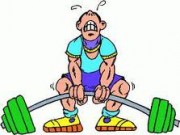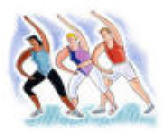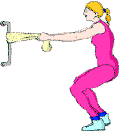Natural Cures
 The following article is a small excerpt from one of my books. I hope you’ll want to learn more and let me help you to get into the best shape of your life.
The following article is a small excerpt from one of my books. I hope you’ll want to learn more and let me help you to get into the best shape of your life.
Common sense may tell you that if you have a small medical problem, you should go to your family doctor. But there are many solutions to your health problems that you can find around your house! I’d love to share with you some alternative health methods of solving simple health problem with things that are commonly found around your house. This section is dedicated to sharing ideas of what you can do for yourself and your family to help prevent colds and flues, and other simple ailments that may help to reduce your pain, discomfort and much more. If you have a home remedy that you would LOVE to share…I’d love to post it on my site to share with others.
EMAIL ME your remedy.
There are many things that are suggested below and I recommended that you always consult your doctor if your symptoms last more than a few days or is intense in severity. These pages are to be used as a guide and not to be used in replacement of competent medical advice.
You have a first-degree burn
Putting ice on your burn cuts circulation, and you need healthy blood cells for healing. Instead, expel excess heat by running cool water over the burn for several minutes, then cut an onion in half and let it rest on the wound. Onions contain a mild analgesic.
Another method is using tomato’s which contains lycopene, a natural anti-inflammatory, so it calms inflamed skin. And the wetness of the tomato juice helps draw some of the liquid out of the burn, reducing swelling. Slice a large tomato and apply pieces to damaged skin. Leave on for five minutes, then remove, letting the remaining juices fully dry on skin. Once dry, rinse skin with cool water. Repeat twice daily until discomfort ends.
Toe Nail Fungus
Some products on the market take many months to stop the infection – some have adverse side affects! Emery’s Finger and Toenail Tonic is a very effective treatment that stops the infection in approximately 10-14 days. Older infections may take longer. It is 100% natural, has no harmful chemicals, no drugs, no side effects and is affordable! This Tonic will stop and kill Toe Nail Fungus resulting in a new healthy nail.
You have a sliver
Light a candle and pour melted wax on your hand, and let the wax harden, then peel it off. This should free the more stubborn pieces. Then use the sticky side of duct tape or roll a lint brush over the area to pick up any stragglers. Gently, of course.
You feel like being sick
Sailors swear by ginger to suppress seasickness and general nausea. But there’s an acupuncture trick that works just as well if you’re feeling queasy. Find the pressure point “pericardium number six”: From the heel of your palm, measure three finger widths toward your elbow. In the center of the wrist area, tape a golf ball snug against that point, and your stomach should calm down.
You have A Urinary-Tract Infection
When you get a urinary track infection, you want protein (a steak) to make your urine more acidic, and then by drinking cranberry juice, which will help to release the cranberry juices bacteria-bashing Hippuric acid.
You have a Scrape or Gash
Wash your wound, then squeeze a lotion like Lubriderm directly onto it, and slap on a bandage. This locks in the moisture and may help new skin cells form. Don’t touch your cut with your hand you use to hold the bottle it may transfer bacteria.
You can also use tea bags. The tannic acid in tea has an astringent effect, prompting blood vessels to constrict more quickly, which slows the flow of blood. Using light pressure, hold a cool (not warm) tea bag against the cut for one minute. Rinse, then cover with a bandage.
You have a Skin Blister
The skin under a blister is already growing in a sterile environment, so popping it won’t speed the recovery. You need to keep bacteria away and the bubble intact. Apply an antibiotic ointment like Neosporin, and then protect it with a bandage.
You have a Side Stitch
Ever get a stitch that feels like a dagger in your side? Exhale deeply and hold. Inhale. Repeat. “It’s a muscle spasm in your diaphragm,”. “The deep exhale will contract the entire muscle and sync all the fibers in it.”
You have a Razor Nick
Clean and apply pressure to the cut, then wipe the top of your antiperspirant with a tissue, swipe the fresh stick with a Q-tip, and dab some onto the nick. “The aluminum chloride in deodorant can help close the nick.
You have a Sore throat
Gargle with warm salt water (1/4 teaspoon of salt top ½ cup of water) and do this several times a day. Also you can drink a glass of hot water with one teaspoon of lemon juice with some honey. You’ll feel better almost instantly
You have low energy
Sprinkle fresh ground cinnamon on your porridge, cereal, toast or whatever you are having to eat. Cinnamon can triple the ability of your insulin to metabolize glucose.
You Have a Bad Cough
To stop night time coughing in a child or an adult, put Vicks Vapor Rub generously on the bottom of your feet at bedtime and then cover with socks. I was raised, and raised my daughter with Vicks. This is amazing! It works 100 percent of the time, although researchers who discovered it aren’t sure why.
Even persistent, heavy, deep coughing will stop in about five minutes and stay stopped for many, many hours of relief.
Cough medicines in kids often do more harm than good due to the chemical makeup of these strong drugs, but Vicks vapor rub on the bottom of the feet was found to be more effective than prescribed medicines for children and in addition to a soothing and calming effect on sick children they will go on to sleep cough-free for hours every night.
Prevent blisters on your feet with deodorant
Blisters are caused by skin rubbing against your shoes, and are made worse by sweating. Deodorant works on your feet just like it does under your arms: It stops sweat glands from producing sweat. Before heading out, roll deodorant—any kind will do—on your soles.
Calm insect bites with aspirin
Aspirin is made of salicylic acid, a potent anti-inflammatory that can reduce pain and itching. Crush three aspirin and add a few drops of water—enough to make a paste. Apply mixture to the bite. Leave on for two minutes, then rinse with cool water. Repeat twice daily until pain and itching stop.
Remove warts with duct tape
Experts found this remedy could clear warts in two months. There are a few theories about how it works. One is that duct tape irritates warts, causing an immune system reaction that attacks them. Another is that the tape removes the virus-laden skin cells. Apply a piece of tape that’s the same size as the wart and leave on for six days. (If tape falls off, replace ASAP.) Remove tape after the six days and clean area with soap and water; leave tape off overnight. In the morning, reapply tape, keep on for five days and repeat until wart disappears. It may take up to two months, but it’s less painful and less expensive than repeated doctor visits.
Nix dandruff with apple cider vinegar
The vinegar’s acidity reduces the natural pH of the scalp and this creates an unfriendly environment for yeast that tend to overpopulate the head and cause dandruff. Mix 1/2 cup of apple cider vinegar with one quart of water and use as a final rinse after shampooing, twice weekly.
Home remedies, no matter who swears they work, are more often bunk than bona fide fixes. But some actually do have science on their side and, in fact, perform even better than their traditional medical counterparts. We dug into the research, talked with the experts, and found 18 treatments that passed. But nothing substitutes the great advice given by your health care provider…if symptoms persist please consult with them or let them know what you are planning to do to help alleviate your symptoms. Here are some more tips that have been emailed to me recently.
Cure cuticle infections with vinegar.
The natural antibacterial properties of vinegar can eliminate infections caused by an overzealous manicurist or picking at cuticles. Apply white wine vinegar combined with warm water for 15 minutes a day.
Eliminate dandruff with a DIY aspirin shampoo.
Aspirin is basically salicylic acid, the anti-acne ingredient that sloughs off dead skin. “It does the same thing for your scalp—gets rid of flakes.” Add 1 tablespoon of crushed aspirin to your regular shampoo, suds up, and leave the soaped-up shampoo in for 5 to 10 minutes.
Ease nausea with ginger.
Your mom was right. Ginger accelerates stomach emptying and helps break up and release intestinal gas. Sip on ginger ale or ginger tea, or slowly eat a few candies made with real ginger.
Beat a migraine with sex.
But don’t just go through the motions, 43% of those who found relief in the sheets said their symptoms improved only after orgasm, according to a recent study. The researchers speculate that endorphins may cause pain to subside.
Bypass motion sickness with lemon.
Motion sickness is often accompanied by excess salivating. Tannins (bitter, astringent plant compounds) found in lemons (olives, too) dry out your mouth, eliminating saliva and, in turn, easing nausea.
Heal cracked heels with Krazy glue.
No amount of cream or moisturizer will bring that crack back together, Krazy Glue is a great little trick to fix it. Soak your feet in water for a few minutes, then apply moisturizer and dab the glue on any remaining cracks. Just one application should do the trick. The challenge will be to avoid getting it on your hands.
Get rid of corns with licorice.
Coating the affected area with a mixture of licorice and oil, then covering it with plastic wrap and a sock while you sleep, gives the estrogen-like substances in licorice time to work their softening magic.
Treat eczema with baking soda.
Eczematic skin tends to be more acidic, and baking soda brings it back to a more neutral pH and sloughs off some of that dead, flaking skin. Combine 1 Tbsp baking soda with warm bathwater, and soak for 15 minutes, 3 times a week.
Soothe a sore throat with sage tea.
A study in the European Journal of Medical Research found that a spray containing 15% sage offered significant relief within just 2 hours, compared with a placebo. Try DIY sage tea: Pour 1 cup of almost-boiling water over 2 tablespoons fresh sage or 1 tablespoon dried. Cover and steep 10 to 15 minutes, then strain.
Solve stinky feet with rubbing alcohol.
Its dehydrating properties kill flourishing bacteria and fungus and eliminate excess perspiration problems at the root of odors. Dampen a cotton ball with rubbing alcohol and wipe over the bottoms of your feet in the morning to minimize moisture and control odor all day.
Stop a migraine with ice.
Applying ice to your temples or the back of your neck for 10 to 15 minutes numbs the nerve that’s sending the pain signal and constricts blood vessels. Plus, the icy sensation on your skin helps distract from the pain.
Halt a respiratory tract infection with salt water.
Start swishing at the first sign of trouble. If you’re dealing with tonsillitis rather than a regular cough, add some salt to help clear out the bits of food that can get stuck in tonsils and often cause the problem. Doing so led to a 36% reduction in peak-season respiratory tract infections, according to a study published in the American Journal of Preventive Medicine.
Kick athlete’s foot with garlic.
A study in the Journal of the American Academy of Dermatology reported that ajoene, an antifungal compound found in garlic, can reduce the signs and symptoms of every gym-goer’s worst foe. Crush a few cloves, mix with olive oil, and use a cotton ball to rub the mixture on the affected area several times a day until the infection clears up.
Ease tinnitus with nature sounds.
Research published in the Journal of the American Academy of Audiology found that digitally produced sounds mimicking nature and water provided significant relief from tinnitus. A white-noise machine with nature sound settings or a nature sound app on your phone will do the trick.
Cure swimmer’s ear with a vinegar.
Vinegar acidifies the external auditory canal, killing the bacteria that cause swimmer’s ear. Dilute white vinegar with an equal amount of distilled water and, using an eyedropper, put 3 drops in the affected ear 3 times daily.
Fix indigestion with licorice and peppermint.
A study in Digestion found that an herbal preparation of licorice root and peppermint leaves eased indigestion. Licorice increases mucus production for a soothing effect, and peppermint relaxes the sphincter in the esophagus, which acts up during indigestion. Licorice and peppermint candies can provide similar relief, as can teas containing either or both.
Experience less anxiety with peppermint essential oil.
Research from Wheeling Jesuit University suggests keeping this feel-good scent on hand to sniff when stress levels start to bubble over. Doing so led study participants to have 20% less self-reported anxiety and 25% less frustration. My DMG brand also has stress and sleep sprays that generate amazing results.
I know you want to get in shape and look great. Whatever your fitness goal…to slim down…gain muscle…tone your arms or flatten your tummy…I’m here to help you accomplish your goals and to improve your fitness level. If you have enjoyed this article and the many other free features on my site, and would like some more comprehensive information such as fitness books and CD’s to aid you in achieving your health and fitness goals, please visit my ONLINE STORE where you will find innovative natural health and beauty products to help you become the BEST YOU CAN BE !


 In my upcoming CD on natural health and nutrition I make my viewpoint known about the Flu and that you don’t ‘catch’ the flu but you create an environment in your body that is toxic which helps you to get sick. But with this said, the following is the mainstream thoughts on the flu and flu shots.
In my upcoming CD on natural health and nutrition I make my viewpoint known about the Flu and that you don’t ‘catch’ the flu but you create an environment in your body that is toxic which helps you to get sick. But with this said, the following is the mainstream thoughts on the flu and flu shots. The following article is a small excerpt from one of my books. I hope you’ll want to learn more and let me help you to get into the best shape of your life.
The following article is a small excerpt from one of my books. I hope you’ll want to learn more and let me help you to get into the best shape of your life. I hope you’ll want to learn more and let me help you to get into the best shape of your life.
I hope you’ll want to learn more and let me help you to get into the best shape of your life. I hope you’ll want to learn more and let me help you to get into the best shape of your life.
I hope you’ll want to learn more and let me help you to get into the best shape of your life.
 I hope you’ll want to learn more and let me help you to get into the best shape of your life.
I hope you’ll want to learn more and let me help you to get into the best shape of your life. If your technique isn’t right, you’re just an injury waiting to happen. That’s why you need to seek advice from a pro. You’re only as good as the advice you get.
If your technique isn’t right, you’re just an injury waiting to happen. That’s why you need to seek advice from a pro. You’re only as good as the advice you get. If your sport is multidirectional, your warm-up should be, too. If your groin, back, and leg muscles aren’t ready, you’ll pull up in pain. Before the game, run backward, forward, sideways, and in quick combos of all directions.
If your sport is multidirectional, your warm-up should be, too. If your groin, back, and leg muscles aren’t ready, you’ll pull up in pain. Before the game, run backward, forward, sideways, and in quick combos of all directions. Buy running shoes and foot wear after work. Shop at night, when your feet are swollen after a day of pounding. It approximates how big your feet will be after the first 3 miles of your run.
Buy running shoes and foot wear after work. Shop at night, when your feet are swollen after a day of pounding. It approximates how big your feet will be after the first 3 miles of your run. Crash landings require stuntman like instincts. You want to be as aerodynamic as possible when you hit, so just go with the fall and let your body roll through the impact.
Crash landings require stuntman like instincts. You want to be as aerodynamic as possible when you hit, so just go with the fall and let your body roll through the impact. Check your water losses. Weigh yourself before and after a long workout in hot weather. If you’ve lost more than 3 pounds by the time you’re finished, you’re dehydrated and could be at risk of heatstroke. Invest in a water pack so you can easily sip throughout your workout.
Check your water losses. Weigh yourself before and after a long workout in hot weather. If you’ve lost more than 3 pounds by the time you’re finished, you’re dehydrated and could be at risk of heatstroke. Invest in a water pack so you can easily sip throughout your workout. The following article is a small excerpt from one of my books. I hope you’ll want to learn more and let me help you to get into the best shape of your life.
The following article is a small excerpt from one of my books. I hope you’ll want to learn more and let me help you to get into the best shape of your life. The following article is a small excerpt from one of my books. I hope you’ll want to learn more and let me help you to get into the best shape of your life.
The following article is a small excerpt from one of my books. I hope you’ll want to learn more and let me help you to get into the best shape of your life. The following article is a small excerpt from one of my books. I hope you’ll want to learn more and let me help you to get into the best shape of your life.
The following article is a small excerpt from one of my books. I hope you’ll want to learn more and let me help you to get into the best shape of your life.